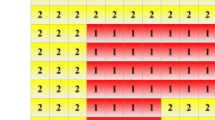Abstract
The exact calculation of point kinetic parameters is very important in nuclear reactor safety assessment, and most sophisticated safety codes such as RELAP5, PARCS, DYN3D, and PARET are using these parameters in their dynamic models. These parameters include effective delayed neutron fractions as well as mean generation time. These parameters are adjoint-weighted, and adjoint flux is employed as a weighting function in their evaluation. Adjoint flux calculation is an easy task for most of deterministic codes, but its evaluation is cumbersome for Monte Carlo codes. However, in recent years, some sophisticated techniques have been proposed for Monte Carlo-based point kinetic parameters calculation without any need of adjoint flux. The most straightforward scheme is known as the “prompt method” and has been used widely in literature. The main objective of this article is dedicated to point kinetic parameters calculation in Tehran research reactor (TRR) using deterministic as well as probabilistic techniques. WIMS-D5B and CITATION codes have been used in deterministic calculation of forward and adjoint fluxes in the TRR core. On the other hand, the MCNP Monte Carlo code has been employed in the “prompt method” scheme for effective delayed neutron fraction evaluation. Deterministic results have been cross-checked with probabilistic ones and validated with SAR and experimental data. In comparison with experimental results, the relative differences of deterministic as well as probabilistic methods are 7.6 and 3.2%, respectively. These quantities are 10.7 and 6.4%, respectively, in comparison with SAR report.





Similar content being viewed by others
References
J.J. Duderstadt, L.J. Hamilton, Nuclear Reactor Analysis (Wiley, Hoboken, 1976), p. 234
S.C. Van der Marck, R.K. Meulekamp, Calculating the effective delayed neutron fraction using Monte Carlo techniques. Paper presented at PHYSOR 2004—The Physics of Fuel Cycles and Advanced Nuclear Systems: Global Developments Chicago, Illinois, April 25–29, 2004
A. Muhammad, M. Iqbal, T. Mahmood et al., Calculation and measurement of kinetic parameters of Pakistan Research Reactor-1 (PARR-1). Ann. Nucl. Energy 38, 44–48 (2011). https://doi.org/10.1016/j.anucene.2010.08.019
M. Iqbal, T. Mahmood, Sh Pervez, Flow of kinetic parameters in a typical swimming pool type research reactor. Ann. Nucl. Energy 35, 518–524 (2008). https://doi.org/10.1016/j.anucene.2007.07.024
A. Muhammad, M. Iqbal, T. Mahmood, Kinetic parameters study based on Burn-up for improving the performance of research reactor equilibrium core. Nucl. Technol. Radiat. 29(4), 253–258 (2014). https://doi.org/10.2298/NTRP1404253M
J.E. Hoogenboom, Methodology of continuous-energy adjoint Monte Carlo for neutron, photon and coupled neutron-photon transport. Nucl. Sci. Eng. 143, 99–120 (2003). https://doi.org/10.1007/978-3-642-18211-2_98
P.K. Meulekamp, S.C. Van der Marck, Calculating the effective delayed neutron fraction with Monte Carlo. Nucl. Sci. Eng. 152, 142–148 (2006)
V. Becares, S. Perez-Martin, M. Vazquez-Antolin et al., Review and comparison of effective delayed neutron fraction calculation methods with Monte Carlo codes. Ann. Nucl. Energy. 65, 402–410 (2014). https://doi.org/10.1016/j.anucene.2013.11.038
W.M. Stacey, Nuclear Reactor Physics, 2nd edn. (Wiley, Hoboken, 2007), pp. 145–146
A.F. Henry, Nuclear Reactor Analysis (MIT University of Technology, Cambridge, 1975)
Atomic Energy Organization of Iran (AEOI), Safety analysis report for Tehran research reactor (2001)
Nuclear Energy Agency (NEA), WIMSD-5B: A neutronic code for standard lattice physics analysis (Code Manual 2003)
T.B. Fowler, D.R. Vondy, G.W. Cunninghan, Nuclear reactor core analysis code-CITATION. (USAEC, Report ORNL-TM-2496, ORNL-4078, ReV.2, 1971)
Argonne National Laboratory (ANL-5800), Reactor Physics Constants, 2nd edn. (United States Atomic Energy Commission, 1963)
M. Carta, S. Dulla, V. Peluso et al., Calculation of the effective delayed neutron fraction by deterministic and Monte Carlo methods. Sci. Technol. Nucl. Ins. 2011(584256), 8 (2011). https://doi.org/10.1155/2011/584256
J.F. Briesmeister, MCNP4C manual, Monte Carlo N-particle transport code system, RSICC code package CCC-700/MCNP4C, (Oak Ridge National Lab., TN, and DOE, USA 2000)
M. Zaker, Effective delayed neutron fraction and prompt neutron lifetime of Tehran research reactor. Ann. Nucl. Energy. 30, 1591–1596 (2003). https://doi.org/10.1016/S0306-4549(03)00081-1
T. Downar, Y. Xu, T. Kozlowski, et al., PARCS v2.7 U.S.NRC Core Neutronics Simulator User Manual, (Purdue University and RES/U.S. NRC, USA, 2006)
Author information
Authors and Affiliations
Corresponding author
Rights and permissions
About this article
Cite this article
Kheradmand Saadi, M., Abbaspour, A. Effective point kinetic parameters calculation in Tehran research reactor using deterministic and probabilistic methods. NUCL SCI TECH 28, 171 (2017). https://doi.org/10.1007/s41365-017-0323-7
Received:
Revised:
Accepted:
Published:
DOI: https://doi.org/10.1007/s41365-017-0323-7




